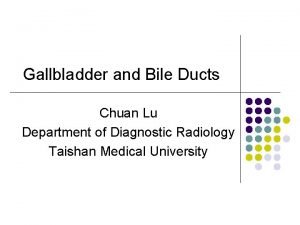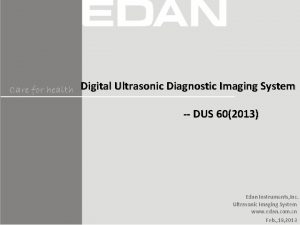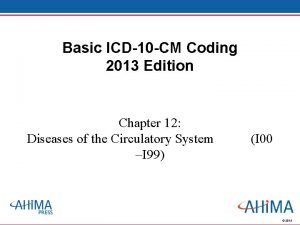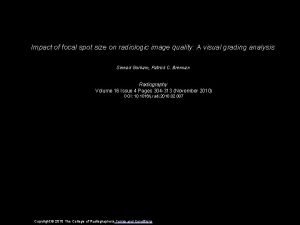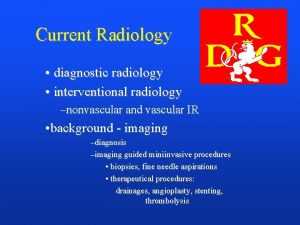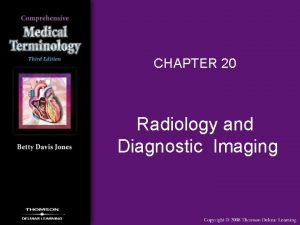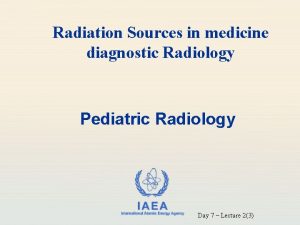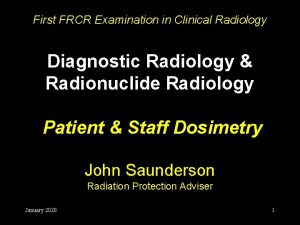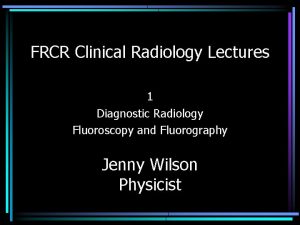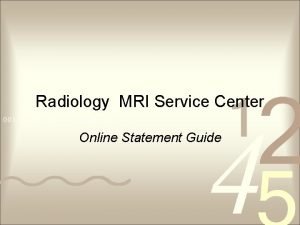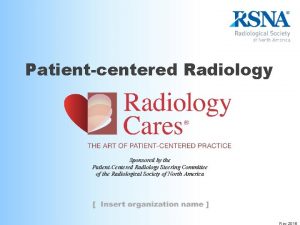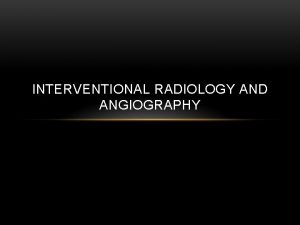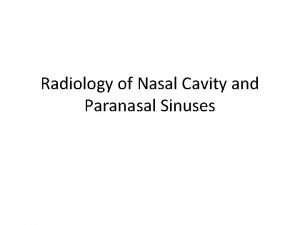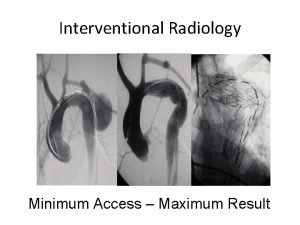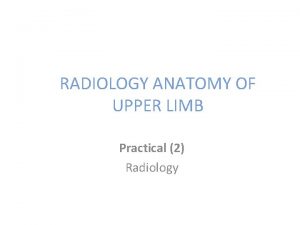Chapter 12 Image Quality in Digital Radiology Diagnostic




































- Slides: 36

Chapter 12 Image Quality in Digital Radiology Diagnostic Radiology Part : Digital Radiology 1

Transition from conventional to digital radiology v Digital images can be numerically processed v Digital images can be easily transmitted through networks and archived v Attention should be paid to the potential increase of patient doses due to tendency of : vproducing more images than needed vproducing higher image quality not necessarily required for the clinical purpose Diagnostic Radiology Part : Digital Radiology 2

Radiation dose in digital radiology Ø Conventional films allow to detect mistakes if a wrong radiographic technique is used : images are too white or too black Ø Digital technology provides user always with a “good image” since its dynamic range compensates for wrong settings even if the dose is higher than necessary Diagnostic Radiology Part : Digital Radiology 3

What is “dynamic range”? ^Wide dose range to the detector, allows a “reasonable” image quality to be obtained ^Flat panel detectors (discussed later) have a dynamic range of 104 (from 1 to 10, 000) while a screen-film system has approximately 101. 5 Diagnostic Radiology Part : Digital Radiology 4

Characteristic curve of CR system 3. 5 HR-III 3 CEA Film-Fuji Mammofine Density 2. 5 2 1. 5 CR response 1 0. 5 0 0. 001 0. 1 1 Air Kerma (m. Gy) Diagnostic Radiology Part : Digital Radiology 5

Digitizing conventional films i Conventional radiographic images can be converted into digital information by a “digitizer”, and electronically stored i Such a conversion also allows some numerical post-processing i Such a technique cannot be considered as a “ digital radiology” technique. Diagnostic Radiology Part : Digital Radiology 6

Analogue versus digital Analogue: A given parameter can have continuous values Digital: A given parameter can only have discrete values Diagnostic Radiology Part : Digital Radiology 7

Different number of pixels per image: original was 3732 x 3062 pixels x 256 grey levels (21. 8 Mbytes). Here, resized at 1024 x 840 (1. 6 MB). Diagnostic Radiology Part : Digital Radiology 8

Different number of pixels per image: original was 3732 x 3062 pixels x 256 grey levels (21. 8 Mbytes). Here, resized at 128 x 105 (26. 2 k. B). Diagnostic Radiology Part : Digital Radiology 9

Different number of pixels per image: original was 3732 x 3062 pixels x 256 grey levels (21. 8 Mbytes). Here, resized at 64 x 53 (6. 6 k. B) Diagnostic Radiology Part : Digital Radiology 10

Digital radiology process v Image acquisition v Image processing v Image display è Importance of viewing conditions v Image archiving (PACS) v Image retrieving è Importance of time allocated to retrieve images Diagnostic Radiology Part : Digital Radiology 11

Image quality • Diagnostic information content in digital radiology is generally higher than in conventional radiology if equivalent dose parameters are used • The wider dynamic range of the digital detectors and the capabilities of post processing allow to obtain more information from radiographic images Diagnostic Radiology Part : Digital Radiology 12

Tendency to increase dose ? v For digital detectors, higher doses result in a better image quality (less “noisy” images) v When increasing dose, the signal to noise ratio is improved v Thus, a certain tendency to increase doses could happen specially in those examinations where automatic exposure control is not usually available. Diagnostic Radiology Part : Digital Radiology 13

Computed radiography versus film screen • In computed radiography (CR) the “image density” is automatically adjusted by the image processing, no matter of the applied dose. • This is one of the key advantages of the CR which helps to reduce significantly the retakes rate. • Underexposures are easily corrected by radiographers (too noisy image). • Overexposures cannot be detected unless patient dose measurements are performed Diagnostic Radiology Part : Digital Radiology 14

Ø Underexposure results in a “too noisy” image Ø Overexposure yields good images with unnecessary high dose to the patient Ø Over range of digitiser may result in uniformly black area with potential loss of information Exposure level 2, 98 Exposure level 2, 36 Diagnostic Radiology Part : Digital Radiology 15

An underexposed image is “too noisy”. Exposure level 1, 15 Exposure level 1, 87 Diagnostic Radiology Part : Digital Radiology 16

Diagnostic Radiology Part : Digital Radiology 17

Exposure level b Some digital systems provide the user with an “exposure level” index which expresses the dose level received at the digital detector b It orientates the operator about the goodness of the radiographic technique used b The relation between dose and exposure level is usually logarithmic: doubling the dose to the detector, will increase the “exposure level” to a factor of 0. 3 = log(2). b Some digital systems offer a color code or a bar in the previsualization monitor. This bar indicates whether the dose received by the detector is in the normal range (green) or it is too high (red color). Diagnostic Radiology Part : Digital Radiology 18

• Example of bar in the image showing the level of dose received by the digital detector Diagnostic Radiology Part : Digital Radiology 19

Risk to increase doses ì The wide dynamic range of digital detectors allows to obtain good image quality while using high dose technique at the entrance of the detector and at the entrance of the patient ì With conventional screen film systems such a choice is not possible since high dose technique always results in a “too black” image. Diagnostic Radiology Part : Digital Radiology 20

Dose in Digital fluoroscopy b. In digital fluoroscopy there is a direct link between diagnostic information (number of images and quality of the images) and patient dose b. Digital fluoroscopy allows producing very easily a great number of images. b. As a consequence of that : dose to the patient is likely to increase without any benefit Diagnostic Radiology Part : Digital Radiology 21

Actions that can influence image quality b. Avoid bad viewing conditions (e. g. lack of monitor brightness or contrast, poor spatial resolution, etc) b. Improve insufficient skill to use the workstation capabilities to visualize images (window level, inversion, magnification, etc). b. Reduce artifacts due to incorrect digital post-processing (creation of false lesions or pathologies) Diagnostic Radiology Part : Digital Radiology 22

Influence of the different image compression levels b. Image compression may: b required for image storage capibility in the PACS bmodify the time necessary to have the images available (transmission speed in the intranet) b. A too high level of image compression may result in a loss of image quality and, consequently, in a possible repetition of the examination. Diagnostic Radiology Part : Digital Radiology 23

Digital radiography: initial pitfalls b. Lack of training and knowledge of the viewing possibilities on the monitors and post-processing capabilities. b. Lack of a preliminary image visualization on the monitors may result in a loss of diagnostic information (wrong contrast and window levels selection) b. Drastic changes in radiographic techniques or geometric parameters without paying attention to patient doses. Diagnostic Radiology Part : Digital Radiology 24

Important aspects for the QA programs in digital radiology b. Availability of procedures avoiding loss of images due to network problems or electric power supply. b. How to avoid that radiographers delete images. b. Information confidentiality b. Compromise between image quality and compression level in the images b. Recommended minimum time to archive images b. Specific reference levels Diagnostic Radiology Part : Digital Radiology 25

Initial basic quality control b. A first tentative approach could be: bto obtain images of a test object under different radiographic conditions bto decide the best compromise considering both image quality and patient dose aspects Diagnostic Radiology Part : Digital Radiology 26

Optimisation technique TOR(CDR) plus ANSI phantom to simulate chest and abdomen examinations and to evaluate image quality Diagnostic Radiology Part : Digital Radiology 27

Optimization technique for Abdomen AP Simulation with TOR(CDR) + ANSI phantom 81 k. Vp, 100 cm (focus-film distance) 1. 6 m. Gy Diagnostic Radiology Part : Digital Radiology 28

Optimisation technique for Chest PA Simulation with TOR(CDR) + ANSI phantom 125 k. Vp, 180 cm (focus-film distance) * Grid focalised at 130 cm 0. 25 m. Gy Diagnostic Radiology Part : Digital Radiology 29

Image quality comparison Diagnostic Radiology Part : Digital Radiology 30

Routine QC programme b. Not affected by change to CR b. Patient dose evaluation (when optimised) b. Tube-generator controls (except. AEC) b. Affected by change to CR b. Image quality evaluation with test object b. Image quality evaluation with clinical criteria b. Image receptors (film-screen, viewing. . . ) b. Automatic processors b. Image processing Diagnostic Radiology Part : Digital Radiology 31

QC equipment b. Available b. TOR(CDR) image quality test b. Photometer b. Densitometer b. Dosimeters b. CR image quality test object b. SMPTE image test b. Pencil type photometer Diagnostic Radiology Part : Digital Radiology 32

Diagnostic Radiology Part : Digital Radiology 33

Diagnostic Radiology Part : Digital Radiology 34

Where to Get More Information • Balter S. Interventional fluoroscopy. Physics, technology and safety. Wiley-Liss, New York, 2001. • ICRP draft on Dose Management in Digital Radiology. Expected for 2003. • PACS. Basic Principles and Applications. Huang HK. Wiley – Liss, New York, 1999. • Vano E, Fernandez JM, Gracia A, Guibelalde E, Gonzalez L. Routine Quality Control in Digital versus Analog Radiology. Physica Medica 1999; XV(4): 319 -321. Diagnostic Radiology Part : Digital Radiology 35

Where to Get More Information (2) • http: //www. gemedicalsystems. com/rad/ xr/education/dig_xray_intro. html (last access 22 August 2002). • http: //www. agfa. com/healthcare/ (last access 22 August 2002). Diagnostic Radiology Part : Digital Radiology 36
 Diagnostic radiology department
Diagnostic radiology department Image transform in digital image processing
Image transform in digital image processing What is image restoration in digital image processing
What is image restoration in digital image processing Arithmetic coding in digital image processing
Arithmetic coding in digital image processing Key stages in digital image processing
Key stages in digital image processing Analog image and digital image
Analog image and digital image Objective fidelity criteria
Objective fidelity criteria Image sharpening and restoration
Image sharpening and restoration Geometric transformation in digital image processing
Geometric transformation in digital image processing Steps of image processing
Steps of image processing Image transform in digital image processing
Image transform in digital image processing Maketform matlab
Maketform matlab Noise
Noise Digital ultrasonic diagnostic imaging system
Digital ultrasonic diagnostic imaging system Diagnostic and procedural coding
Diagnostic and procedural coding Chapter 23 specimen collection and diagnostic testing
Chapter 23 specimen collection and diagnostic testing Chapter 15 diagnostic procedures and pharmacology
Chapter 15 diagnostic procedures and pharmacology Diagnostic coding chapter 18
Diagnostic coding chapter 18 Chapter 12 basics of diagnostic coding
Chapter 12 basics of diagnostic coding Chapter 24 diagnostic tests and specimen collection
Chapter 24 diagnostic tests and specimen collection Quality control and quality assurance
Quality control and quality assurance Quality management pmp
Quality management pmp Quality metrics pmp
Quality metrics pmp Quality assurance model in nursing management
Quality assurance model in nursing management Compliance vs quality
Compliance vs quality Concepts of quality control
Concepts of quality control Quality gurus of tqm
Quality gurus of tqm Quality is free: the art of making quality certain
Quality is free: the art of making quality certain Old quality vs new quality
Old quality vs new quality Gap model of service quality with examples
Gap model of service quality with examples Upgrade image quality
Upgrade image quality Image information and visual quality
Image information and visual quality Universal image quality index
Universal image quality index Contoh pelembutan citra
Contoh pelembutan citra Recorded detail in radiography
Recorded detail in radiography Radi
Radi Spatial resolution
Spatial resolution
